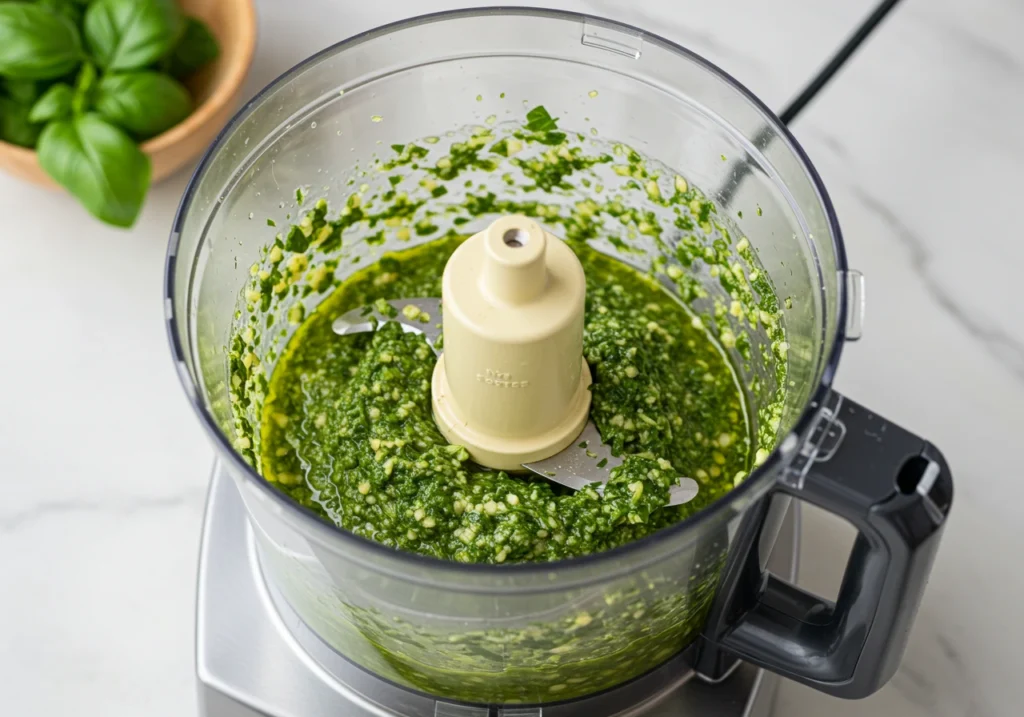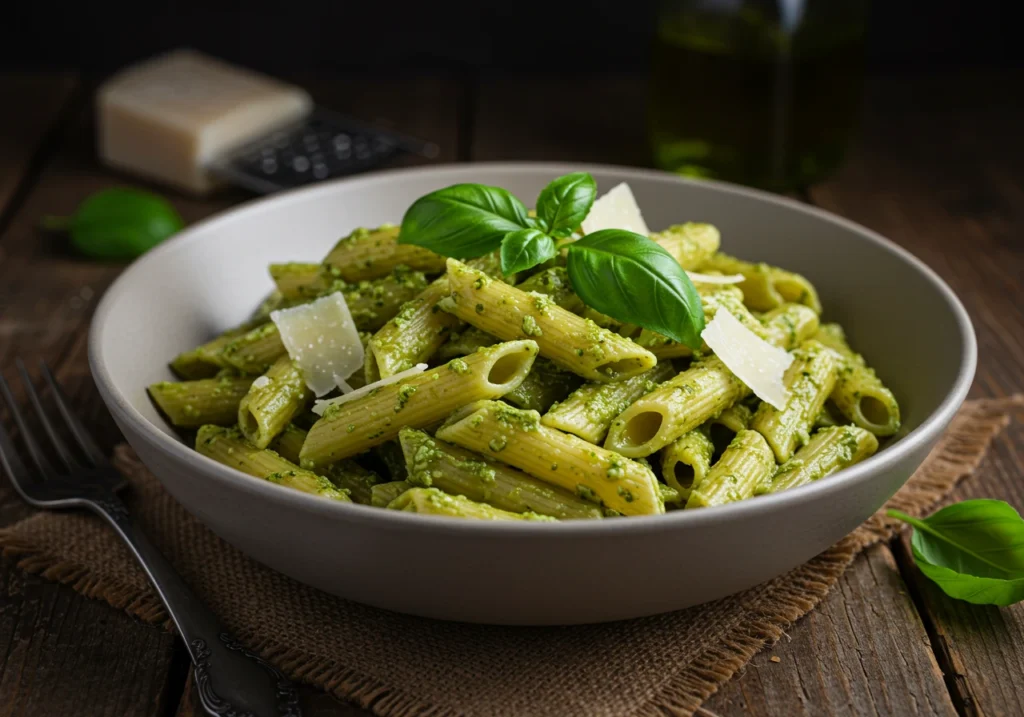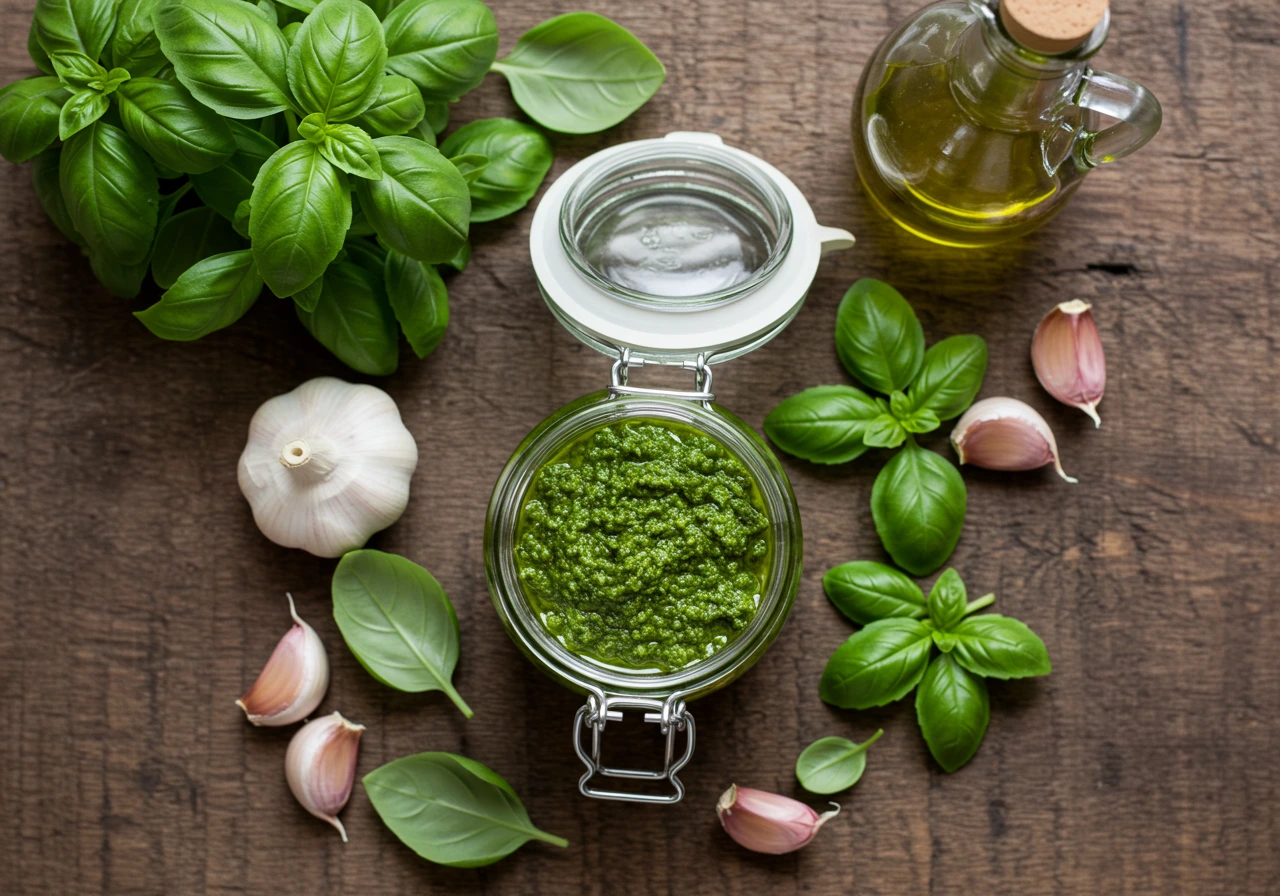Introduction
Pesto is one of those magical condiments that can instantly elevate any dish, whether it’s a classic pasta, a hearty sandwich, or even a grilled protein. Traditionally, pesto is made with basil, garlic, Parmesan, olive oil, and pine nuts, giving it a rich, nutty flavor. However, what if you don’t have pine nuts on hand or you’re looking for a budget-friendly or allergy-friendly alternative? That’s where this pesto recipe without pine nuts comes in!
This recipe keeps all the vibrant green freshness and creamy texture of classic pesto while swapping out pine nuts for more accessible and affordable alternatives. Whether you’re using walnuts, almonds, cashews, or even sunflower seeds, this pesto will impress with its bold flavor and creamy consistency.
So, let’s dive into the history, benefits, ingredients, and the step-by-step process of making your own homemade pesto without pine nuts!
Part 1: Understanding Pesto and Why Skip Pine Nuts
What is Pesto? A Timeless Italian Sauce
Pesto is a bright green, herbaceous sauce that originates from the Liguria region of Italy, specifically Genoa. Its name comes from the Italian word “pestare,” meaning “to crush” or “to pound,” referring to the traditional method of making pesto using a mortar and pestle. This process allows the ingredients to blend together harmoniously, resulting in a sauce that’s bursting with freshness, nuttiness, and umami flavors.
Though the traditional pesto alla Genovese is made with pine nuts, modern variations incorporate a wide range of ingredients, allowing for different textures and flavors while keeping the essence of this beloved sauce intact.
Why Make Pesto Without Pine Nuts?
Cost-Effective Alternative
Let’s face it—pine nuts are expensive! Due to their labor-intensive harvesting process, pine nuts tend to be one of the priciest nuts available. Substituting them with other nuts like walnuts, almonds, or cashews can significantly cut down costs without sacrificing taste.
Allergy-Friendly Option
Nut allergies are common, and while pine nuts are technically seeds, they can still trigger allergic reactions in some people. Using substitutes like sunflower seeds, pumpkin seeds, or even hemp seeds creates a delicious nut-free pesto alternative.
Different Flavor Profiles
Each nut or seed alternative brings a unique taste and texture to pesto. For instance:
- Walnuts add a deep, earthy richness.
- Almonds bring a slightly sweet and mild crunch.
- Cashews create a creamy, buttery consistency.
- Sunflower seeds add a mild, nutty taste, perfect for nut-free diets.
Experimenting with different alternatives allows you to customize your pesto to your liking!
The Key Ingredients for a Perfect Pesto Recipe Without Pine Nuts
A good pesto is all about balance. Here’s what you’ll need:

1. Fresh Basil Leaves
The star ingredient! Basil gives pesto recipe its signature green color and fresh, slightly peppery taste. Always use fresh basil, as dried basil won’t deliver the same vibrant flavor.
2. Garlic
A small clove of garlic goes a long way in adding that sharp, aromatic punch. If you prefer a milder taste, roasting the garlic beforehand can mellow out its intensity.
3. Parmesan Cheese (or a Vegan Alternative)
Parmesan adds a salty, umami depth that brings everything together. If you’re making a dairy-free or vegan pesto, nutritional yeast is an excellent substitute!
4. Extra-Virgin Olive Oil
A high-quality olive oil is essential! It acts as the binding agent, giving the pesto a smooth and luscious texture. Cold-pressed extra-virgin olive oil works best for its rich, fruity undertones.
5. Alternative Nuts or Seeds
- Walnuts (earthy and rich)
- Almonds (mild and slightly sweet)
- Cashews (buttery and creamy)
- Sunflower seeds (nut-free and mild)
6. Salt & Pepper
A pinch of salt enhances the flavors, while fresh cracked black pepper adds a slight kick. Adjust to taste!
How Different Nuts and Seeds Affect the Flavor
| Ingredient | Flavor Profile | Best For |
|---|---|---|
| Walnuts | Earthy, slightly bitter | Classic pesto lovers |
| Almonds | Mild, slightly sweet | Balanced, subtle flavor |
| Cashews | Buttery, rich, creamy | Creamy, smooth texture |
| Sunflower Seeds | Light, nutty, mild | Nut-free alternative |
| Pumpkin Seeds | Mild, slightly sweet | Nut-free, earthy pesto |
Each of these alternatives offers a unique twist on traditional pesto, allowing you to explore different textures and flavors based on your personal preference.
Part 2: Making pesto recipe Without Pine Nuts
Benefits of Making pesto recipe Without Pine Nuts
Cost-Effectiveness: A Budget-Friendly Alternative
If you’ve ever shopped for pine nuts, you’ve probably noticed their sky-high price tag. That’s because they require a labor-intensive harvesting process, making them one of the most expensive nuts on the market. By swapping them for more affordable alternatives like walnuts, almonds, or sunflower seeds, you can enjoy a flavorful, high-quality pesto at a fraction of the cost.
For example, walnuts are often half the price of pine nuts and provide a similar creamy texture. Almonds, on the other hand, add a light sweetness, making them a great budget-friendly substitute. If you want a completely nut-free option, sunflower seeds are an excellent choice that delivers a mild nuttiness.
Flavor Profile: A Delicious Twist on a Classic
Beyond cost savings, skipping pine nuts opens up a world of exciting flavor variations. Different nuts and seeds enhance the overall taste of pesto, offering unique undertones:
- Walnuts add a deep, earthy richness.
- Almonds create a mild, slightly sweet profile.
- Cashews bring in a buttery, smooth texture.
- Sunflower seeds offer a nut-free, subtly nutty alternative.
Depending on your personal taste, you can craft a pesto that’s bolder, creamier, or milder, ensuring a perfect pairing for whatever dish you’re making.
Ingredients for pesto recipe Without Pine Nuts
To achieve a smooth, balanced, and aromatic pesto, using high-quality ingredients is essential. Here’s what you’ll need:
Fresh Basil Leaves
The soul of pesto! Basil provides that vibrant green color and unmistakable peppery, slightly sweet aroma. Always use fresh basil, as dried basil lacks the brightness and depth that makes pesto shine.
Garlic
A little goes a long way! Garlic brings in that bold, slightly spicy flavor. If you prefer a milder taste, roast the garlic beforehand for a sweeter, more mellow kick.
Alternative Nuts (or Seeds) for Creaminess
- Walnuts: Earthy and slightly bitter
- Almonds: Mild and subtly sweet
- Cashews: Buttery and creamy
- Sunflower seeds: Nut-free, mild, and nutty
Each of these alternatives brings a different texture and taste, making your pesto uniquely delicious!

Parmesan Cheese (or Vegan Alternative)
This is where you get that umami, salty depth. If you’re dairy-free, substitute Parmesan with nutritional yeast, which provides a similar cheesy flavor.
Extra-Virgin Olive Oil
The key ingredient for a silky-smooth consistency! A cold-pressed, high-quality olive oil enhances the flavor, binding everything together into a rich, pourable sauce.
Salt & Pepper
A simple sprinkle of salt enhances all the flavors, while black pepper adds just a touch of warmth. Adjust according to taste!
Step-by-Step Guide to Making pesto recipe Without Pine Nuts
1. Preparing the Ingredients
Before blending, prep your ingredients to ensure a smooth process:
Wash and dry the basil leaves thoroughly (wet leaves will make the pesto watery).
Peel and chop the garlic (if using raw).
Grate the Parmesan cheese (if not using pre-shredded).
Measure the olive oil, nuts, and seasonings for easy mixing.
2. The Blending Process: Creating the Perfect Texture
Step 1: Add the garlic and chosen nuts (or seeds) to a food processor. Pulse for a few seconds until finely chopped.
Step 2: Add the fresh basil leaves and grated Parmesan (or nutritional yeast). Pulse again until everything is evenly combined.
Step 3: With the food processor running, slowly drizzle in the olive oil. This emulsifies the pesto, creating a smooth, creamy consistency.
Step 4: Stop the food processor and scrape down the sides. If the pesto is too thick, add a little more olive oil to loosen it up.
3. Adjusting the Seasoning to Perfection
Taste the pesto and adjust the seasoning.
Add a pinch of salt for depth.
Sprinkle black pepper for a mild spice.
If you prefer a tangy twist, squeeze in a few drops of lemon juice to brighten the flavors.
4. Blending Until Just Right
Blend until smooth but slightly textured—you don’t want it overly processed! The best pesto has a bit of graininess, giving it that rustic homemade feel.
And that’s it! Your fresh, vibrant pesto without pine nuts is now ready to be used on pasta, sandwiches, grilled vegetables, or anything that needs a burst of herby goodness!
Part 3: Storing and Using pesto recipe Without Pine Nuts
Once you’ve made your delicious, vibrant green pesto, the next step is to store it properly to maintain its freshness, color, and bold flavor. Since pesto is made with fresh ingredients, it can oxidize quickly, turning brown if not stored correctly. But don’t worry! With the right methods, you can keep it fresh and ready to use whenever you need a burst of flavor in your dishes.
Storage Tips for Homemade Pesto
Refrigeration: Keeping pesto recipe Fresh for a Week
If you plan to use your pesto within a few days, the refrigerator is the best option. Here’s how to store it properly:
Transfer the pesto into an airtight glass jar or container to minimize air exposure.
Smooth the top layer and pour a thin layer of olive oil over it—this prevents oxidation and preserves its bright green color.
Store it in the coldest part of the fridge, and it will stay fresh for up to one week.
Before using, give it a quick stir to reincorporate the oil.
Freezing: Long-Term Storage for Up to Six Months
For longer storage, freezing pesto recipe is an excellent way to keep it fresh for months:
Ice Cube Tray Method – Spoon pesto into an ice cube tray, cover it with plastic wrap, and freeze. Once frozen, transfer the cubes into a freezer-safe bag for easy portioning.
Small Container Method – Store pesto in small freezer-safe jars or airtight containers for larger portions.
Shelf Life – Frozen pesto stays fresh for up to six months.
Thawing – Take out the desired amount and let it thaw in the fridge for a few hours before use.
Pro Tip: Avoid freezing pesto recipe with cheese—add Parmesan after thawing for the best texture and taste!

Culinary Uses of pesto recipe Without Pine Nuts
Pesto is one of the most versatile sauces, adding instant flavor to countless dishes. Whether you’re making a quick weeknight dinner or an elaborate gourmet meal, there’s always a way to incorporate pesto!
Pasta Dishes: The Ultimate Classic
Nothing beats a classic pesto pasta! Simply:
Cook your favorite pasta (spaghetti, penne, fusilli, or linguine).
Toss the hot pasta with a few tablespoons of pesto, allowing the heat to melt the flavors together.
Add a splash of reserved pasta water to create a silky, evenly coated sauce.
Top with grated Parmesan, cherry tomatoes, or grilled chicken for an extra treat!
Sandwich Spread: Elevate Your Lunch Game
Swap out mayo or mustard for pesto on sandwiches and wraps!
Spread a thin layer on toasted bread for added depth.
Use it in a grilled cheese sandwich to take it to the next level.
Pair it with turkey, chicken, mozzarella, or avocado for a flavor-packed meal.
Pizza Base: A Tasty Tomato Sauce Alternative
Want to switch things up? Use pesto instead of tomato sauce for a fresh, herbaceous pizza.
Spread a thin layer over pizza dough.
Top with mozzarella, cherry tomatoes, and grilled vegetables.
Bake until the cheese is bubbly and golden.
Marinade for Proteins: Infuse Rich Flavors
Pesto makes an incredible marinade for chicken, fish, shrimp, or tofu.
Coat the protein in pesto and let it marinate for at least 30 minutes.
Grill, roast, or pan-fry for a juicy, herb-infused meal.
Works wonderfully for vegetables like zucchini, eggplant, and bell peppers too!
Salad Dressing: A Fresh & Zesty Boost
Thin out pesto with lemon juice, vinegar, or extra olive oil for a quick, homemade dressing.
Drizzle over a Caprese salad with tomatoes and fresh mozzarella.
Toss with arugula, spinach, or kale for a flavorful green salad.
Use as a grain bowl dressing—it pairs perfectly with quinoa and farro!
Part 4: Nutritional Information and Dietary Considerations
Eating homemade pesto is not only delicious but also nutritious! By removing pine nuts, this version retains all the health benefits of classic pesto while offering dietary flexibility for different lifestyles. Let’s dive into why pesto without pine nuts is a superfood powerhouse and how you can adjust it for various dietary needs.
Nutritional Benefits of Pesto Without Pine Nuts
Pesto is more than just a tasty sauce—it’s a nutrient-dense condiment packed with healthy fats, vitamins, and antioxidants that can boost overall well-being.
Healthy Fats: Heart-Healthy Goodness
Many of the alternative nuts used in pesto—like walnuts, almonds, and cashews—are rich in unsaturated fats, particularly omega-3 fatty acids. These heart-healthy fats can help:
Reduce inflammation
Lower cholesterol levels
Improve brain function
Among the substitutes, walnuts are the best source of omega-3s, making them an excellent choice for a heart-healthy pesto.
Antioxidants: Fighting Free Radicals
The key ingredients in pesto—basil, garlic, and olive oil—are loaded with antioxidants that help fight oxidative stress and promote overall wellness.
Basil is rich in polyphenols, which help reduce inflammation and support a healthy immune system.
Garlic contains allicin, known for its antibacterial and immune-boosting properties.
Olive oil is packed with oleic acid, which supports heart health and helps fight inflammation.
These antioxidant-rich ingredients make pesto a flavorful and nutritious addition to your meals.
Vitamins and Minerals: A Nutrient Powerhouse
Homemade pesto is loaded with essential vitamins and minerals that nourish the body:
Vitamin K (from basil) – Supports bone health and blood clotting.
Calcium (from Parmesan cheese) – Essential for strong bones and teeth.
Vitamin E (from olive oil and nuts) – A powerful antioxidant for skin and cell health.
Magnesium (from nuts and seeds) – Helps with muscle function and relaxation.
With such a nutrient-rich profile, pesto isn’t just a sauce—it’s a health-boosting powerhouse!
Dietary Modifications
One of the best things about pesto is how easily customizable it is. Whether you’re following a vegan, dairy-free, or nut-free diet, there’s a variation that suits your needs.
Vegan Pesto: Dairy-Free & Plant-Based
Traditional pesto includes Parmesan cheese, but making it vegan-friendly is easy! Simply replace Parmesan with:
Nutritional yeast – Offers a cheesy, umami flavor without dairy.
Cashews – Adds a creamy texture and slight sweetness.
Vegan Parmesan – Many store-bought brands mimic the taste of real cheese.
💡 Pro Tip: Add a squeeze of lemon juice to boost flavor and balance out the richness of the nuts and olive oil.

Nut-Free Pesto: Allergy-Friendly Alternative
For those with nut allergies, replacing nuts with seeds is the perfect way to enjoy pesto safely. Some great nut-free substitutes include:
Sunflower seeds – Mild, slightly nutty flavor.
Pumpkin seeds – Adds an earthy taste and extra magnesium.
Hemp seeds – High in protein and omega-3s, making them a superfood choice.
💡 Pro Tip: Toasting seeds before blending enhances their flavor and adds a subtle depth to the pesto.
With these simple modifications, anyone can enjoy the rich, herby taste of pesto—regardless of dietary restrictions!
Part 5: Frequently Asked Questions (FAQs)
Pesto is a versatile, flavorful sauce that can be easily customized. If you’re making it without pine nuts, you might have a few questions about substitutes, ingredients, and common issues. Here are the most frequently asked questions about making pesto without pine nuts!
What is a good substitute for pine nuts in pesto?
If you’re looking to replace pine nuts, there are several great alternatives that maintain the creamy texture and rich taste of traditional pesto:
Walnuts – Earthy, slightly bitter, and closest in texture to pine nuts.
Almonds – Mild, slightly sweet, and adds a subtle crunch.
Cashews – Buttery and creamy, making the pesto extra smooth. Sunflower Seeds – A nut-free alternative with a mild, nutty taste.
Pumpkin Seeds – Slightly sweet and packed with nutrients.
💡 Pro Tip: Toasting the nuts or seeds before blending can enhance their flavor and add a rich, roasted taste to your pesto.
Can you leave pine nuts out of pesto?
Absolutely! You can make a delicious pesto without pine nuts by:
Using walnuts, almonds, or cashews for a traditional taste.
Opting for nut-free alternatives like sunflower or pumpkin seeds.
Skipping nuts/seeds altogether—this results in a lighter, slightly less creamy pesto, but still full of flavor!
Even without nuts, the combination of fresh basil, garlic, olive oil, and Parmesan creates a bold, herby sauce that works well in pasta, sandwiches, and salads.
What are the three main ingredients in pesto?
Classic pesto is built on three essential ingredients:
Fresh Basil – The key herb that gives pesto its signature green color and fragrant aroma.
Extra Virgin Olive Oil – Binds everything together and adds a smooth, silky texture.
Parmesan Cheese – Provides a salty, umami-rich depth to the flavor.
Other traditional ingredients include garlic, nuts (or seeds), and salt, but the basil, olive oil, and Parmesan are the core elements of any great pesto.
Why does my pesto taste bitter?
If your pesto tastes bitter, a few common culprits might be responsible:
Over-blending the basil – Too much processing can release bitter compounds from the basil leaves. Try pulsing instead of blending continuously.
Using low-quality olive oil – Some oils have a natural bitterness. Choose a high-quality extra virgin olive oil for a smoother taste.
Garlic overpowering the mix – Raw garlic can be strong and sharp. If it’s too intense, try roasting or using less garlic.
Nuts going rancid – Old or stale nuts can turn bitter. Always use fresh, high-quality nuts or seeds.
💡 Fix it: If your pesto tastes bitter, try adding a pinch of salt, extra Parmesan, or a squeeze of lemon juice to balance the flavors.

